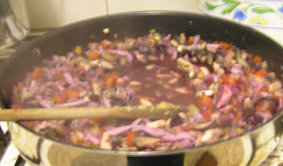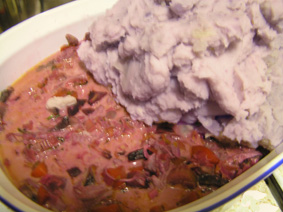I’ve just been reading Green Gourmet Giraffe‘s blog post about the difficulties of making genuinely blue food. She’s right, of course – really bright blue food is hard to come by without excessive use of food colouring (though I do believe there is a place for the excessive use of food colouring in cooking). But her post made me smile nonetheless, because while food in a good shade of blue may be difficult to achieve, in my experience it is all too easy to create food in a highly-suspicious-looking, mouldy-verging-on-cyanotic-lips, greyish-green kind of blue shade – using all-natural, organic and fresh ingredients!
(getting people to eat such food is a little more difficult, but fortunately I work with starving PhD students, and also with scientists)
Basically, most dark red and purple fruits and vegetables get their coloration from a chemical called anthocyanin, which works as a sort of food litmus test – if you add it to something acidic (pH below 7), it goes red, but if you add it to a base (pH above 7), it goes blue. Litmus tests are very nearly the only thing I remember from chemistry at school, so I’m quite pleased that they apply here! I could probably google a list of fruit and veg containing anthocyanins, but I don’t really need to – based on the foods I have turned funny colors over the years I can tell you with confidence that they definitely occur in raspberries, blood oranges (but not ordinary oranges), purple carrots, sapphire potatoes, and red cabbage. In fact, anthocyanins are the reason why recipes for red cabbage always have a bit of vinegar or lemon juice in the recipe – apparently very few people will actually eat bluish cabbage.
I discovered the interesting properties of anthocyanins last year, when I started making practice cupcakes for a wedding cake. Some of the guests required gluten-free cakes, and since it was blood orange season and the wedding had a red and gold colour scheme, I thought it would be fun to make flourless blood orange cakes. I boiled the oranges and blended them to a very promising blood-red pulp, and then added the eggs, almonds and sugar – and the whole mix went greyish-blue. This was a little disconcerting, but the mix tasted really good, and I honestly couldn’t believe that the cakes were seriously going to turn out blue, so I decided to bake them anyway.
It turned out that while they did brown to a nice golden shade on the outside and tasted deliciously orangey, they were still a suspicious blue-green colour in the middle. Naturally, I took them in to work to share with my hungry scientists, who were very excited about the whole thing (and also entirely willing to eat blue cakes, bless them), and started speculating madly on chemical mechanisms. A little research uncovered the fact that egg whites have a sufficiently high pH to turn blood orange juice blue (though not a good blue – I can’t reiterate often enough how bad a blue this is), and were probably also responsible for the unfortunate Blue Macaron Incident of 2010.
Sadly, I have no photos of blue cakes to show you, but I do have much more recent photos of disconcertingly-coloured food to share – and an example of anthocyanins working in the opposite direction.  Exhibit A is from dinner last night, the filling for a nice, classic chicken and vegetable pie:
Exhibit A is from dinner last night, the filling for a nice, classic chicken and vegetable pie:
Not the best photo in the world, but you can see that the dish is purple from the purple carrots, and shading to pink in the foreground where I added some lemon juice. I conclude from this that purple carrots contain anthocyanins, and also that they normally have a fairly high pH. Incidentally, this dish started life as a chicken pot pie, but having accidentally turned it purple, I decided that the only possible thing to do was to top it with purple potato mash. And look at this! When you add lemon juice to the (very pale lavender, not that you can see it terribly well) mashed potato, it starts going pink too! More anthocyanins at work!
When you add lemon juice to the (very pale lavender, not that you can see it terribly well) mashed potato, it starts going pink too! More anthocyanins at work!
How awesome is that? An entirely pink and purple dinner with no food colourings whatsoever… and it tastes exactly like (and is) a completely normal potato-topped chicken and vegetable pie.
To be honest, I do feel a sneaking disappointment that it didn’t taste more purple, if you know what I mean. I suspect I’ve been watching too much Heston Blumenthal. But it was a rather tasty pie, despite its rather alarming appearance.
6 comments for “Kitchen Chemistry – Anthocyanins and Blue Food”
 Christine | May 24, 2011 at 3:05 am
Christine | May 24, 2011 at 3:05 am
My experience is that most if not all purple vegetables are anthocyanins. I loved this blog post. Chemistry is fun!
 Catherine | May 24, 2011 at 7:45 am
Catherine | May 24, 2011 at 7:45 am
Which means I need to find out right now whether I can make blue beetroot…
 Iestyn | May 24, 2011 at 5:37 am
Iestyn | May 24, 2011 at 5:37 am
I don’t think you can watch too much Heston Blumenthal.
 Catherine | May 24, 2011 at 7:45 am
Catherine | May 24, 2011 at 7:45 am
It’s certainly a difficult thing to imagine…!
 JohannaGGG | May 25, 2011 at 4:16 pm
JohannaGGG | May 25, 2011 at 4:16 pm
What a great response to my blue post – did you see some of the comments – one saying she made rose pav and the red rose petals turned it blue – and another talking about myth busters finding there was no truly blue food – so this just makes sense of these. I am no scientist but I love a bit of nerdy food talk – just a shame the blue you create through this process doesn’t seem like the bright cartoon blue that would be so much fun – though I guess people might not want to eat that either
 Catherine | May 25, 2011 at 4:24 pm
Catherine | May 25, 2011 at 4:24 pm
Oh, interesting! There weren’t any comments when I first looked, but the rose pav sounds like it was the same mechanism at work (not that I’m a scientist either, of course).


